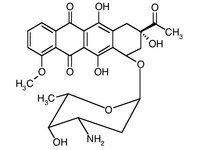Definition
Idarubicin is a medication that kills cancer cells.
Purpose
As of 2001, idarubicin is approved to treat only one single cancer, acute myelocytic leukemia (AML) in adults. Recent research suggests that using idarubicin rather than the more traditional daunorubicin in treating AML results in higher rates of complete remission (CR) and longer survival for patients. CR is the total elimination of all diseased cells detectable following therapy. The Food and Drug Administration (FDA) has not approved idarubicin as treatment for acute lymphocytic leukemia (ALL).
Much research involving idarubicin is now being conducted. Some of this has involved acute lymphocytic leukemia (ALL) as well as AML. For example, a recent study was conducted in patients with either AML or ALL who had received bone marrow transplantation and then relapsed. Patients received a combination of cytarabine, idarubicin, and etoposide, as well as a medicine called G-CSF (filgrastim). This treatment achieved a high CR rate in these patients.
Another recent study looked at the use of idarubicin in children with AML. All of the children received cytarabine and etoposide. In addition, some of the children received idarubicin, while some received daunorubicin. Overall, patients in both groups fared equally well in terms of survival length. However, patients who had larger numbers of cells known as blasts (immature cells) tended to do better if they received idarubicin rather than daunorubicin. In addition, high-risk patients tended to do better with idarubicin than with daunorubicin. No subgroup of patients achieved better outcomes with daunorubicin than with idarubicin.
Description
Idarubicin is an antibiotic, although doctors do not use this drug to attack infections. Its only use is to kill cancer cells. It does so by affecting how the DNA of cancer cells work.
Recommended dosage
In the treatment of AML, 12 mg of idarubicin per square meter may be given over a period of two to three days every three weeks in combination with other medications. Patients with liver problems may be given lower doses than other patients receive. Idarubicin is not typically given by mouth, as an insufficient amount of the medication would be transported through the stomach wall if this were done. Rather, this medication is usually administered through an intravenous (IV) procedure. During this time, it circulates widely throughout the body.
A new formulation of idarubicin has been developed. This permits idarubicin to be taken orally. However, this formulation is currently available only in France and only for older patients who are not good candidates for intensive intravenous treatment. There is little information currently available on the effectiveness of this oral formulation. The studies that have been performed suggest that it is less effective than other formulations of idarubicin.
Precautions
Idarubicin may be associated with excessive toxicity in patients with congestive heart failure, liver function characterized by a high bilirubin level, or prior chest radiation to the heart.
Side effects
Like daunorubicin and doxorubicin, idarubicin may adversely affect the patient's heart. However, doctors are not certain how much of the drug it takes to cause such harm and, therefore, how to limit dosage so that such harm is not caused. However, idarubicin appears to be less likely to cause heart damage than similar drugs such as daunorubicin and doxorubicin. Another serious side effect that limits how much of the drug is given to patients is its potential adverse effect upon the bone marrow, where blood cells are produced.
Idarubicin may cause nausea and vomiting, baldness (alopecia), and stomach problems. In addition, idarubicin may cause blistering if extravasation occurs. Extravasation is when chemotherapy gets outside of the vein during infusion. If this occurs, the drug may cause severe local pain, swelling, or tissue necrosis that may require plastic surgery.
Patients receiving idarubicin in conjunction with certain other anticancer drugs may develop a type of leukemia. However, this is extremely rare.
In the few studies that have been conducted on the oral formulation of idarubicin, the most prominent side effects seen are low blood cell counts, nausea, vomiting, diarrhea, and hair loss.
KEY TERMS
- Bilirubin
- A pigment produced when the liver processes waste products. A high bilirubin level causes yellowing of the skin.
- Blasts
- Immature cells
- Complete remission (CR)
- Complete remission is the total elimination of all diseased cells detectable following therapy.
- Necrosis
- The sum of the morphological changes indicative of cell death. It may affect groups of cells or part of a structure or an organ.



